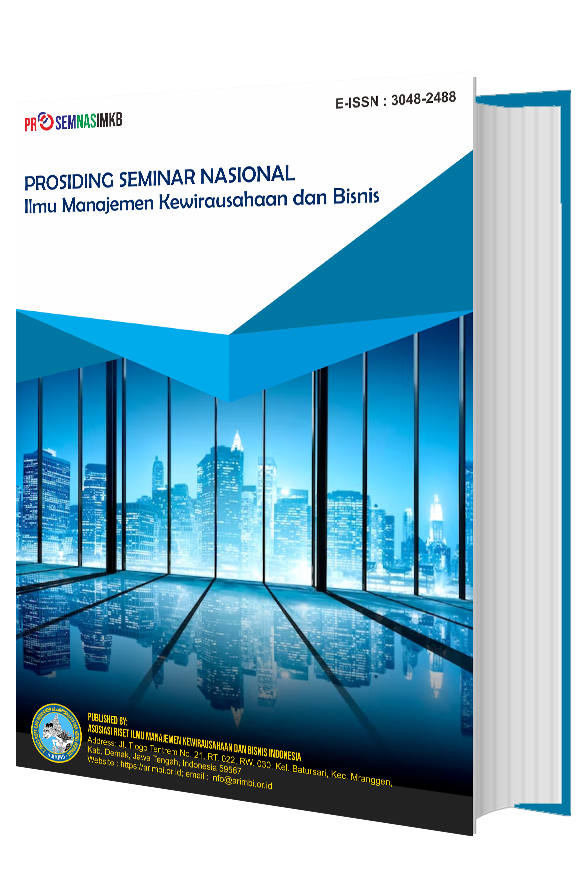Pengaruh Etnosentrisme, Sikap, Norma Subjektif, dan Kontrol Perilaku terhadap Niat Beli Sepatu Lokal Ventela
DOI:
https://doi.org/10.61132/prosemnasimkb.v2i2.195Keywords:
Attitude, Ethnocentrism, Perceived Behavioral Control, Purchase Intention, Subjective NormsAbstract
The dominance of foreign footwear brands in Indonesia remains strong despite the growing awareness of supporting local products. This phenomenon raises questions about the factors that drive consumer purchase intention toward local brands, particularly among younger generations. This study aims to examine the influence of ethnocentrism, attitude, subjective norms, and perceived behavioral control on the purchase intention of Ventela, a local footwear brand, using the Theory of Planned Behavior (TPB) framework. A quantitative approach was employed by distributing questionnaires to 150 respondents in Yogyakarta who had never purchased or used Ventela products. Data were analyzed using Partial Least Squares Structural Equation Modeling (PLS-SEM). The results indicate that ethnocentrism, attitude, subjective norms, and perceived behavioral control significantly and positively affect consumers’ purchase intention toward Ventela. Theoretically, this study extends the application of TPB by incorporating ethnocentrism as an additional predictor of purchase intention for local products. Practically, the findings suggest that producers should emphasize national pride in their marketing strategies, enhance product quality and design, and expand purchasing accessibility. The main limitation of this study lies in its focus on a single brand and a limited sample size, suggesting that future research should broaden the context and include more diverse respondents.
Downloads
References
Ajzen, I. (1991). The theory of planned behavior. Organizational Behavior and Human Decision Processes, 50(2), 179–211. https://doi.org/10.1016/0749-5978(91)90020-T
Ajzen, I. (2015). Consumer attitudes and behavior: The theory of planned behavior applied to food consumption decisions. Italian Review of Agricultural Economics, 70(2), 121–138. https://doi.org/10.13128/REA-18003
Anggi, C., & Ellyawati, J. (2015). Pengaruh etnosentrisme konsumen pada niat beli produk notebook: Uji mediasi variabel persepsi kualitas [Undergraduate thesis, Universitas Atma Jaya Yogyakarta]. UAJY Repository.
Delany, A. E., & Sitio, R. P. (2022). Pengaruh attitude toward behavior, subjective norm dan perceived behavioral control terhadap minat beli green product industri fashion. Media Ekonomi, 22(1), 1–12. https://doi.org/10.30595/medek.v22i1.11280
Ernawati, S. (2019). Pengaruh etnosentrisme dan product knowledge terhadap minat beli produk Tembe Mee Donggo. Distribusi: Journal of Management and Business, 7(2), 215–230. https://doi.org/10.29303/distribusi.v7i2.92
Hagger, M. S., Cameron, L. D., Hamilton, K., Hankonen, N., & Lintunen, T. (Eds.). (2020). The handbook of behavior change. Cambridge University Press. https://doi.org/10.1017/9781108677318
Hagiworo, H. (2021, April 24). Jadi identitas milenial, sneaker lokal tak kalah dengan merek impor. KOMPAS.com. https://money.kompas.com/read/2021/04/24/170322426/jadi-identitas-milenial-sneaker-lokal-tak-kalah-dengan-merek-impor
Hair, J. F., Black, W. C., Babin, B. J., & Anderson, R. E. (2019). Multivariate data analysis (8th ed.). Cengage Learning.
Hair, J. F., Hult, G. T. M., Ringle, C. M., & Sarstedt, M. (2022). A primer on partial least squares structural equation modeling (PLS-SEM) (3rd ed.). SAGE Publications.
Haque, A., Anwar, N., Tarofder, A. K., Ahmad, N. S., & Sharif, S. R. (2018). Muslim consumers’ purchase behavior towards halal cosmetics products in Malaysia. Management Science Letters, 8(12), 1305–1318. https://doi.org/10.5267/j.msl.2018.9.009
Indrawan, M. R., Mulyadi, M., & Furkan, L. M. (2022). Pengaruh celebrity endorser dan etnosentrisme konsumen terhadap minat beli sepatu lokal “Compass” pada mahasiswa S1 di Indonesia. Jurnal Riset Pemasaran, 1(1), 1–12. https://doi.org/10.29303/jrp.v1i1.1752
Jain, S. (2020). Assessing the moderating effect of subjective norm on luxury purchase intention: A study of Gen Y consumers in India. International Journal of Retail & Distribution Management, 48(5), 517–536. https://doi.org/10.1108/IJRDM-02-2019-0042
Kan, M. P. H., & Fabrigar, L. R. (2020). Theory of planned behavior. In V. Zeigler-Hill & T. K. Shackelford (Eds.), Encyclopedia of personality and individual differences (pp. 5476–5483). Springer. https://doi.org/10.1007/978-3-319-24612-3_1191
Kaniawati, K. (2019). Analisis pengaruh psikologi konsumen dan etnosentrisme terhadap minat beli konsumen sepatu di Cibaduyut Bandung (Studi kasus konsumen Diana Shoes Bandung). Jurnal Muara Ilmu Ekonomi dan Bisnis, 3(2), 313–326. https://doi.org/10.24912/jmieb.v3i2.5065
Laraswati, C., & Harti, H. (2022). Pengaruh persepsi kualitas, citra merek dan etnosentrisme konsumen terhadap minat pembelian produk Somethinc. Jurnal Ekobis: Ekonomi Bisnis & Manajemen, 12(2), 185–196. https://doi.org/10.37932/j.e.v12i2.564
Muhdi, K., & Ibnu, W. (2015). Pengaruh etnosentrisme konsumen, persepsi harga dan kemenarikan atribut terhadap sikap produk dan implikasinya terhadap keputusan pembelian di Indonesia. Diponegoro Journal of Management, 4(3), 1–15.
Ningtyas, Y., Fitria, D., Pradani, Y. S., Mutohar, A., Arum, N. P., & Maknun, L. (2021). Analisis pengaruh sikap, norma subjektif, dan persepsi kontrol perilaku terhadap minat beli konsumen pada produk bersertifikat halal. Jurnal Ekonomi, Sosial & Humaniora, 2(8), 123–133.
Noor, N. M., Noranee, S., Zakaria, M. F., Unin, N., & Suaee, M. A. H. M. (2020). Online shopping: The influence of attitude, subjective norm and perceived behavioral control on purchase intention. In Proceedings of the 2020 6th International Conference on E-Business and Applications (pp. 33–36). ACM. https://doi.org/10.1145/3387263.3387266
Salehudin, I. (2021). 100% love Indonesia: Role of government campaign to promote local products in Indonesia. ASEAN Marketing Journal, 8(1), 1–10. https://doi.org/10.21002/amj.v8i1.9324
Sekaran, U., & Bougie, R. (2017). Research methods for business: A skill-building approach (7th ed.). John Wiley & Sons.
Shimp, T. A., & Sharma, S. (1987). Consumer ethnocentrism: Construction and validation of the CETSCALE. Journal of Marketing Research, 24(3), 280–289. https://doi.org/10.2307/3151638
Suki, N. M., & Salleh, A. S. A. (2016). Does halal image strengthen consumer intention to patronize halal stores? Some insights from Malaysia. Journal of Islamic Marketing, 7(1), 120–132. https://doi.org/10.1108/JIMA-12-2014-0079
SurV. (2023, December 8). Melangkah gaya dengan sepatu lokal. Surv.co.id. https://surv.co.id/web/artikel/Melangkah-Gaya-dengan-Sepatu-Lokal
Trisatya, A. A., & Absah, Y. (2022). The effect of consumer ethnocentrism on purchase intention of Indonesian local fashion brands. In Proceedings of the 2nd International Conference on Business and Management of Technology (ICONBMT 2020) (pp. 887–895). Atlantis Press. https://doi.org/10.2991/978-94-6463-008-4_111
Van Loo, E. J., Grebitus, C., & Roosen, J. (2019). Explaining attention and choice for origin labeled cheese by means of consumer ethnocentrism. Food Quality and Preference, 78, 103716. https://doi.org/10.1016/j.foodqual.2019.05.016
Witriyana, Y., Faisal, I., & Rifani, A. (2019). Pengaruh sikap, norma subyektif, kontrol perilaku terhadap minat beli produk secara online di Shopee. Jurnal Ilmu Manajemen Indonesia, 2(1), 1–10.
Zebal, M. A., & Ahmed, M. (2019). Cues for shaping purchase of local retail apparel clothing brands in an emerging economy. International Journal of Retail & Distribution Management, 47(10), 1070–1088. https://doi.org/10.1108/IJRDM-11-2018-0241
Downloads
Published
How to Cite
Issue
Section
License
Copyright (c) 2025 Prosiding Seminar Nasional Ilmu Manajemen Kewirausahaan dan Bisnis

This work is licensed under a Creative Commons Attribution-ShareAlike 4.0 International License.






